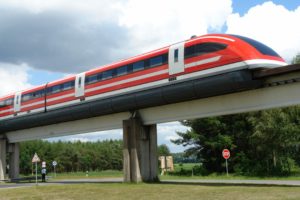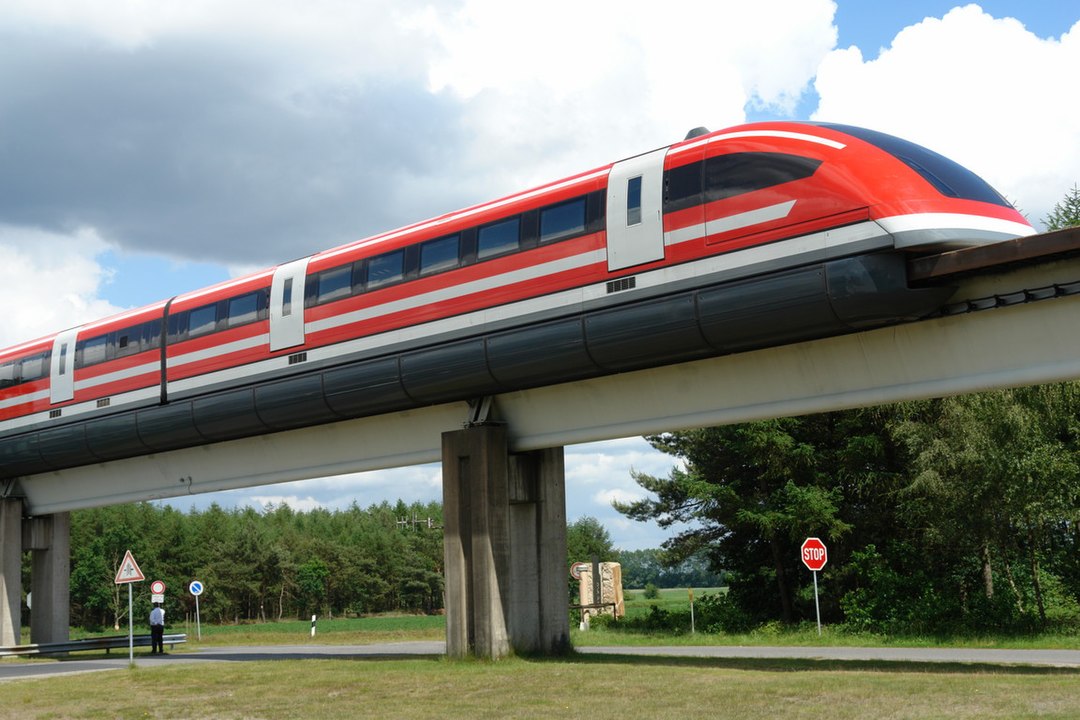
How does a Maglev train work? They use magnets to move the train forwards and to reduce friction.
Maglev is the shortened form of magnetic levitation, and it is a train based on the principle of magnetic attraction and repulsion. We all know that when you have two magnets, the opposite poles attract each other by the like poles attract each other. You can stick a north to a south, but you cannot stick a north to a north. This is because the magnetic field that emanates from the poles contains energy. When you try to stick two of the same poles together, that energy becomes kinetic energy, forcing the two poles apart. If the magnets are not very strong, say fridge magnets, you can supply more energy with your fingers than exists in the magnetic fields and you can overcome the kinetic energy. If the magnets are stronger, it takes far more energy to overcome the kinetic energy.
Maglev trains have magnets on every corner of the train car. They are not the same as the magnets on your fridge, they are electromagnets. These magnets are supercooled because that makes them stronger. They are cooled with liquid helium. When a magnet is cooled to a little above absolute zero, -267.7℃, they become superconductors. That means the material is so cold that the atoms have lost nearly all of their energy and don’t move, lowering their resistance almost to zero. The resistance of a material is connected to the likelihood that an electric current passing through it will collide with atoms. The more moving atoms there are, the greater the likelihood the current will collide with the atoms and the higher its resistance. At supercold temperatures, the atoms don’t move, and the current can pass through cleanly. This gives the electromagnet a lot more power and increases the strength of its magnetic field considerably.
A Maglev train rides in a U shaped concrete track and there are four sets of magnetic fields at work. The first set is produced by the magnets on the corners of the train cars. The second magnetic field is created by a conduction metal set are in the bottom of the track. When the magnets on the train pass over it, their magnetic fields produce a magnetic field in the conductive metal. This field is the same polarity as the field produced by the magnets on the train and they repel each other, causing the train to float above them. The third field is produced by another conductive metal set in the sides of the track. This works in the same way as the one in the bottom of the track, but its job is to repel the train sideways, so it stays in the middle of the track.
The fourth magnetic field is the one that drives the train. There is an electromagnet running along the length of the track that is supplied by an alternating current. This current makes the magnet switch polarity very quickly. The magnets in the corners of the train cars have a north pole facing forwards and south pole facing backwards. The alternating current flips the current in the track from north to south rapidly and the south pole on the track in front of the train pulls the north pole on the train forwards while the north pole on the track behind the train pushes the south pole on the train forwards. This system means that there is no engine on the train because it is propelled by the track it is riding on. No engine means the train can be lighter.
Maglev trains are very smooth because they don’t contact the track. They are also faster than regular trains because they don’t have to deal with the friction of the track. On a regular train, a lot of the engine’s power, and therefore a lot of the speed, is lost through heat to the track due to friction. Maglev trains don’t have to deal with this, and they can use that power for more speed. They are also safer because they can’t go off the rails. Whenever they move too close to one side, the magnetic field in the track pushes them back. The train cannot produce enough energy to overcome the kinetic energy in that magnetic field. They also don’t technically need a driver because the train is driven by the current in the rail. And this is what I learned today.
Image By Állatka – Own work, Public Domain, https://commons.wikimedia.org/w/index.php?curid=7039725
Sources
https://science.howstuffworks.com/transport/engines-equipment/maglev-train.htm
https://blog.pitsco.com/blog/magnetic-attraction
https://www.energy.gov/articles/how-maglev-works
https://new.nsf.gov/science-matters/maglab-makes-magic-magnets
https://en.wikipedia.org/wiki/Superconducting_magnet


[…] as the incline gets greater, the train will start to lose speed due to gravity. The same SC Maglev can only reach 322 km/h on a 10% incline. A maglev train could theoretically go vertically, but […]